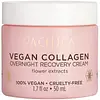What's inside
What's inside
 Key Ingredients
Key Ingredients

 Benefits
Benefits

 Concerns
Concerns

 Ingredients Side-by-side
Ingredients Side-by-side

Water
Skin ConditioningStearyl Alcohol
EmollientCaprylic/Capric Triglyceride
MaskingButyrospermum Parkii Butter
Skin ConditioningGlycerin
HumectantCetearyl Alcohol
EmollientGlyceryl Caprylate
EmollientCetyl Alcohol
EmollientCeramide NP
Skin ConditioningCeramide AP
Skin ConditioningCeramide EOP
Skin ConditioningPhytosphingosine
Skin ConditioningCholesterol
EmollientCalendula Officinalis Flower Extract
MaskingNiacinamide
SmoothingAvena Sativa Kernel Flour
AbrasivePalmitoyl Hexapeptide-19
Skin ConditioningAlthaea Officinalis Leaf/Root Extract
EmollientSodium PCA
HumectantSodium Lactate
BufferingArginine
MaskingAspartic Acid
MaskingPCA
HumectantGlycine
BufferingAlanine
MaskingSerine
MaskingValine
MaskingProline
Skin ConditioningThreonine
Isoleucine
Skin ConditioningHistidine
HumectantPhenylalanine
MaskingGlyceryl Stearate Citrate
EmollientSodium Lauroyl Lactylate
EmulsifyingXanthan Gum
EmulsifyingPhenoxyethanol
PreservativeEthylhexylglycerin
Skin ConditioningPlant Ash
Water, Stearyl Alcohol, Caprylic/Capric Triglyceride, Butyrospermum Parkii Butter, Glycerin, Cetearyl Alcohol, Glyceryl Caprylate, Cetyl Alcohol, Ceramide NP, Ceramide AP, Ceramide EOP, Phytosphingosine, Cholesterol, Calendula Officinalis Flower Extract, Niacinamide, Avena Sativa Kernel Flour, Palmitoyl Hexapeptide-19, Althaea Officinalis Leaf/Root Extract, Sodium PCA, Sodium Lactate, Arginine, Aspartic Acid, PCA, Glycine, Alanine, Serine, Valine, Proline, Threonine, Isoleucine, Histidine, Phenylalanine, Glyceryl Stearate Citrate, Sodium Lauroyl Lactylate, Xanthan Gum, Phenoxyethanol, Ethylhexylglycerin, Plant Ash
Water
Skin ConditioningHelianthus Annuus Seed Oil
EmollientGlycerin
HumectantSr-Hydrozoan Polypeptide-1
HumectantCetyl Esters
EmollientGlyceryl Stearate
EmollientCetyl Alcohol
EmollientStearyl Alcohol
EmollientStearic Acid
CleansingTocopheryl Acetate
AntioxidantDiheptyl Succinate
EmollientCapryloyl Glycerin/Sebacic Acid Copolymer
Skin ConditioningMagnesium Ascorbyl Phosphate
AntioxidantCitrus Aurantium Dulcis Flower Extract
Skin ConditioningJasminum Officinale Extract
MaskingChamomilla Recutita Flower Extract
MaskingArnica Montana Extract
Skin ConditioningAllantoin
Skin ConditioningDipotassium Glycyrrhizate
HumectantXanthan Gum
EmulsifyingPhenoxyethanol
PreservativeEthylhexylglycerin
Skin ConditioningParfum
MaskingWater, Helianthus Annuus Seed Oil, Glycerin, Sr-Hydrozoan Polypeptide-1, Cetyl Esters, Glyceryl Stearate, Cetyl Alcohol, Stearyl Alcohol, Stearic Acid, Tocopheryl Acetate, Diheptyl Succinate, Capryloyl Glycerin/Sebacic Acid Copolymer, Magnesium Ascorbyl Phosphate, Citrus Aurantium Dulcis Flower Extract, Jasminum Officinale Extract, Chamomilla Recutita Flower Extract, Arnica Montana Extract, Allantoin, Dipotassium Glycyrrhizate, Xanthan Gum, Phenoxyethanol, Ethylhexylglycerin, Parfum
 Reviews
Reviews

Ingredients Explained
These ingredients are found in both products.
Ingredients higher up in an ingredient list are typically present in a larger amount.
Cetyl Alcohol is a fatty alcohol. Fatty Alcohols are most often used as an emollient or to thicken a product.
Its main roles are:
Though it has "alcohol" in the name, it is not related to denatured alcohol or ethyl alcohol.
The FDA allows products labeled "alcohol-free" to have fatty alcohols.
Learn more about Cetyl AlcoholEthylhexylglycerin (we can't pronounce this either) is commonly used as a preservative and skin softener. It is derived from glyceryl.
You might see Ethylhexylglycerin often paired with other preservatives such as phenoxyethanol. Ethylhexylglycerin has been found to increase the effectiveness of these other preservatives.
Glycerin is already naturally found in your skin. It helps moisturize and protect your skin.
A study from 2016 found glycerin to be more effective as a humectant than AHAs and hyaluronic acid.
As a humectant, it helps the skin stay hydrated by pulling moisture to your skin. The low molecular weight of glycerin allows it to pull moisture into the deeper layers of your skin.
Hydrated skin improves your skin barrier; Your skin barrier helps protect against irritants and bacteria.
Glycerin has also been found to have antimicrobial and antiviral properties. Due to these properties, glycerin is often used in wound and burn treatments.
In cosmetics, glycerin is usually derived from plants such as soybean or palm. However, it can also be sourced from animals, such as tallow or animal fat.
This ingredient is organic, colorless, odorless, and non-toxic.
Glycerin is the name for this ingredient in American English. British English uses Glycerol/Glycerine.
Learn more about GlycerinPhenoxyethanol is a preservative that has germicide, antimicrobial, and aromatic properties. Studies show that phenoxyethanol can prevent microbial growth. By itself, it has a scent that is similar to that of a rose.
It's often used in formulations along with Caprylyl Glycol to preserve the shelf life of products.
Stearyl Alcohol is a type of fatty alcohol from stearic acid. It is a white, waxy compound used to emulsify ingredients.
Fatty Alcohols are most often used as an emollient or to thicken a product. Emollients help soothe and hydrate the skin by trapping moisture.
They are usually derived from natural fats and oils and therefore do not have the same drying or irritating effect as solvent alcohols. FDA allows products labeled "alcohol-free" to have fatty alcohols.
Learn more about Stearyl AlcoholWater. It's the most common cosmetic ingredient of all. You'll usually see it at the top of ingredient lists, meaning that it makes up the largest part of the product.
So why is it so popular? Water most often acts as a solvent - this means that it helps dissolve other ingredients into the formulation.
You'll also recognize water as that liquid we all need to stay alive. If you see this, drink a glass of water. Stay hydrated!
Learn more about WaterXanthan gum is used as a stabilizer and thickener within cosmetic products. It helps give products a sticky, thick feeling - preventing them from being too runny.
On the technical side of things, xanthan gum is a polysaccharide - a combination consisting of multiple sugar molecules bonded together.
Xanthan gum is a pretty common and great ingredient. It is a natural, non-toxic, non-irritating ingredient that is also commonly used in food products.
Learn more about Xanthan Gum